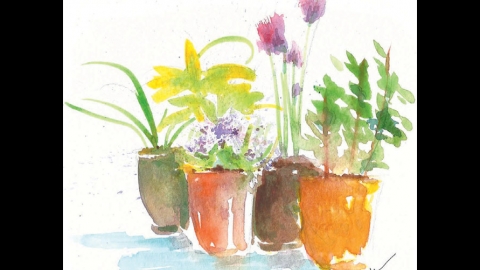Finding Space
Growing Small: Discovering Creative Ways to Enjoy an Edible Garden
Oklahoma’s rich agrarian heritage provides ample encouragement for farms and large edible gardens. With expansive space and historically low cost for land, small farms or large gardens often follow a traditional approach in which rows of vegetables are planted in the ground, grown and harvested. Raised beds are often touted as the best way to have an edible garden. Though the visual intrigue of this approach is compelling, it is but one way to experience the joy of edible gardening.
In reality there are many ways to enjoy growing and using edibles. Rosalind Creasy, author of over 18 books, pioneered the field of edible landscaping and has revolutionized the way many think about gardening. “Gardening can be easy, healthy, inexpensive and best of all, it can be done just about anywhere,” she says on her website, RosalindCreasy.com.
When you consider that a raised bed is only one form of a container, you begin to understand that any container, properly prepared, can be a place for edibles to grow. This understanding, coupled with the realization that the real source of growth is well prepared soil, opens up possibilities that a back-porch container garden, a small unused side yard, even a balcony can become an urban farmer’s delight.
Further, companion planting—using plants as natural resources to inhibit pests and boost production—expands the ideas of rows and rows of vegetables to utilizing edibles throughout the landscape around perennials, shrubs and evergreens. The natural beauty of vegetables and herbs can bring year-round interest, aroma and beauty to traditional perennial gardens and shrub borders.
Gardening well is learned by doing, so it makes sense to start small and grow with your garden, even if your garden is just one tomato plant in a five-gallon bucket (which can net you enough tomatoes for all kinds of slicing and sauce-making fun).
If having a planted garden appeals to you, consider a plot no bigger than 10 by 10 feet, which can adequately support two tomato plants, up to six bell pepper, four zucchini and up to four herbs. In fall and winter months, the same 100-square-foot garden can be home to up 18 cool-weather greens, such as arugula, lettuce and romaine varieties.
Container gardening begins with coordinating the size of the containers to the plants. Choose containers that are at least eight to 12 inches deep (deeper if you’re growing tall plants such as tomatoes) and make sure that there are drainage holes in the bottom. Scatter some stones on the bottom and then add sand so that the soil will drain well, minimizing root diseases such as root rot. If your container is tall, supplement the bottom third of the container with paper grocery bags or cardboard, which break down and begin composting. Avoid using newspaper, which can introduce toxic inks into the growing environment.
Fill up to two-thirds of the container with a rich, nutritious potting soil (not garden soil, which will be heavier and won’t drain as well) that has a pH level of 6.0–7.0, lower levels of nitrogen (under 6%) and other organic matter such as bat guano, earthworm castings and other important nutrients. Check with trusted garden staff or consult your local extension office to ask what works best for your situation.
Water well and consistently and focus moisture on the roots instead of leaves. To discourage fungus, water in the morning hours. Once the growing season begins, feed your plants with a non-synthetic fertilizer every two weeks to keep plants strong and vibrant.
Companion planting is an easily learned approach to gardening and your local extension office and its website can provide helpful information for grouping plants together to provide organic pest control and other gardening benefits. For example, discovering that oregano is an effective ground cover that can grow marvelously under roses and shrubs can solve a weed problem for your perennial garden while providing aroma and evergreen color, not to mention flavor for cooking!
Growing one’s own food is a magical journey that offers wonder and many healthy benefits. Don’t be discouraged if you have only a balcony or small patio or patch. Begin where you are, grow with your garden and enjoy creating an edible oasis.







